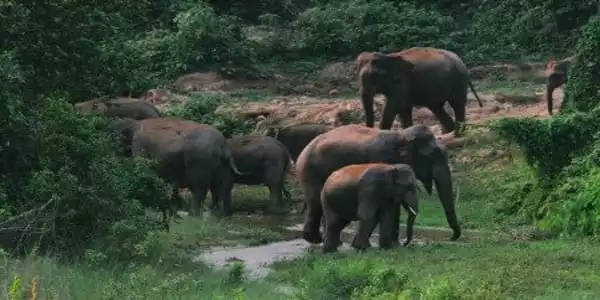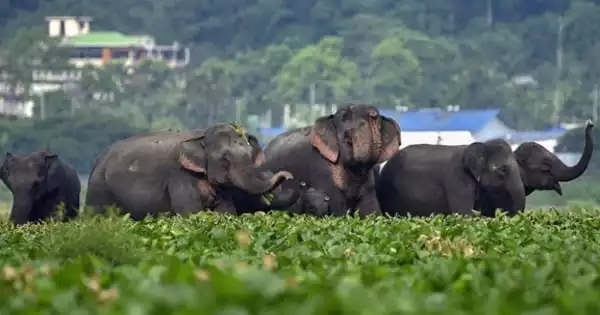Researchers spent years studying the interactions between wildlife, people, and the environment in the Kavango Zambezi Transfrontier Conservation Area, the world’s biggest terrestrial trans-boundary conservation area spanning five African countries.
The conflict between elephants and humans is caused by habitat degradation and fragmentation. When elephants and humans interact, there is conflict resulting from crop-raiding, elephant-caused injuries and deaths, and elephants murdered by humans for causes other than ivory and habitat damage.
Human-wildlife conflict is a major concern in conservation science. Whether it’s the reintroduction of wolves into key ecosystems in the southwestern United States, which is affecting livestock and cattle ranchers, or the ongoing problem of elephants living alongside communities on the African savannah, the effects of this conflict on people’s livelihoods can be significant. Human-elephant conflict, for example, causes crop loss in African settings where rising human and elephant populations struggle for limited resources, and may even result in human injury and death, as well as the retaliatory slaughter of wildlife.
Despite what is known about the issues of human-wildlife conflict, quantifying its impact on human livelihoods is difficult. An international team of researchers, led by Northern Arizona University professor Duan Biggs, spent three years studying the interactions of wildlife, people, and the environment in the Kavango Zambezi Transfrontier Conservation Area, the world’s largest terrestrial trans-boundary conservation area that spans five African countries.
Our findings demonstrating the reliance of both humans and elephants on the same resources, particularly during drought, demonstrate that we need to address the challenge of human-elephant coexistence as well as local responses to climatic change concurrently.
Professor Duan Biggs
The study, led by Colorado State University’s Jonathan Salerno and funded by the National Science Foundation, included a large team of collaborators, including researchers from the University of Colorado Boulder, the University of Louisville, the University of California Berkeley, the University of North Carolina Wilmington, the University of Botswana, the University of Namibia, Stellenbosch University, and Griffith University, as well as The Nature Conservancy South Africa.
The team used interdisciplinary approaches across a wide study area to better understand how climate change interacts with human-elephant conflict to affect household food insecurity, as described in their paper recently published in Current Biology, “Wildlife impacts and changing climate pose compounding threats to human food security.”
The project’s goals were to identify the socio-ecological conditions and patterns that affect household and community vulnerability, as well as to identify leverage points that may aid in mitigating how land-use decisions and land-cover change affect vulnerability in the southern African Kavango Zambezi Transfrontier Conservation Area.

The researchers used a combination of household surveys and participatory mapping to determine how indications of vulnerability influence smallholders’ land use decisions. They used remotely sensed imagery to compare trajectories of land-use and land-cover change with underlying socio-ecological drivers. They combined data on the environment, market factors, government policy and subsidies, culture and ethnicity, and the presence and intervention of non-governmental organizations. This research advances our understanding of vulnerability by identifying how vulnerability influences and is influenced by socioeconomic and biophysical variables at multiple scales.
“The overall goal of the study is to understand human vulnerability and adaptation capacity in the context of environmental change,” Salerno explained. “Taking a systems-level approach to this problem is critical because we’re investigating human vulnerability, which may be defined and impacted by a variety of factors.”
Another significant conclusion of the study was that people in these afflicted areas have the adaptive capacity to obtain food supplies and mitigate the effects of elephant conflict and short rain seasons. While local communities may be resilient, larger institutions such as governments and aid groups are not currently providing adequate assistance for effective risk mitigation or risk reduction techniques for households. In addition to habitat protection, the team believes that suitable resources and funding should be directed toward human-wildlife conflict reduction projects to aid in the conservation of African savannah elephants.
Biggs grew up in southern Africa and has substantial experience in community participation for conservation and human-wildlife conflict. He provided his regional experience and social-ecological expertise to the project.
“Our findings demonstrating the reliance of both humans and elephants on the same resources, particularly during drought, demonstrate that we need to address the challenge of human-elephant coexistence as well as local responses to climatic change concurrently,” Biggs said.
Biggs is an internationally recognized leader in wildlife conservation and the founder of Resilient Conservation, a group of researchers working actively at the interface of science, policy, and practice to enable innovative conservation outcomes in our fast-changing, multi-cultural world. He will join NAU in 2021 as the Charles Olajos and Ted Goslow Chair for Southwestern Environmental Science and Policy in the School of Earth and Sustainability. He is particularly interested in fostering collaborations between researchers and non-governmental organizations (NGOs), governments, and the corporate sector in order to undertake science that informs the creation of conservation initiatives and policies.





